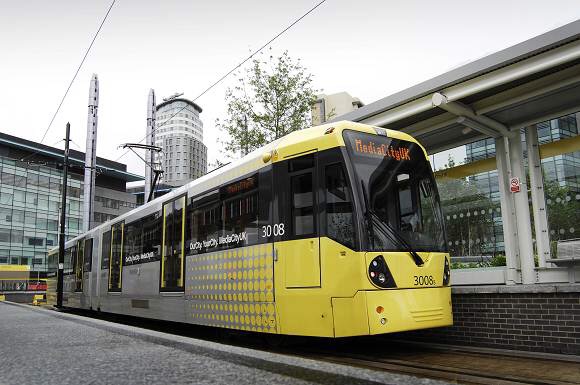Love Your Bike, the cycling advocacy campaign co-ordinated by Manchester Friends of the Earth, has published the results of a survey of people’s experiences of cycling alongside or across Metrolink tram tracks.
The survey highlights that a large majority of respondents feel unsafe when cycling over tram tracks and there are many cases of people suffering serious injuries requiring hospital treatment.
The survey was created after Love Your Bike raised concerns in December 2014 regarding the designs of Metrolink tram routes at road junctions such as Southmoor Road in Wythenshawe.
This was not the first time, cycling organisations had raised concerns with the Metrolink tram track designs. In 2012, Sean Sutton (the British Cycling Head Coach at the time) described the new tram lines near to the Velodrome as ‘death traps‘.
Love Your Bike is concerned that where cyclists have crashed or been injured when cycling close to/across Metrolink tracks they do not report the incident because they blame themselves for a supposed lack of cycling experience or skill.
The survey found that 44% of respondents had fallen off their bicycles when cycling along/ across Metrolink tram tracks. 36% of respondents had caught their bicycle wheels in the tram tracks.
56% of respondents reported damage to their bicycles or clothing, and 56% also reported suffering minor injuries (bruises, grazes). 25% of respondents reported suffering major injuries (broken bones, skin cuts). Further cases of serious injuries were also reported via other sources.
94% of respondents reported that they had felt unsafe “often” or “sometimes” when cycling alongside, close to or across tram tracks. This was “often” for 58% of respondents and “sometimes” for 36%. Only 4% of respondents reported that they “rarely” or 1.4% “never” felt unsafe when cycling alongside, close to or across tram tracks.
45% of respondents reported that they now take a different route and 50% reported being more cautious when cycling near tram tracks. 11% reported that they cycled less often and 3% reported that they have stopped cycling because of Metrolink tram tracks. People have changed their cycling behaviour and some have stopped cycling altogether because of their experience of cycling over Metrolink tram tracks.
Over 85% of incidents were not reported at all. The TfGM response to their Freedom of Information application suggested they had received 9 reports in 2013 and 29 in 2014. Our survey indicates that 23 incidents were not reported in 2013, 70 incidents were not reported in 2014 and 53 in the first six months of 2015.
Love Your Bike believes that many of these incidents are often caused by poor designs. In January 2015, Transport for London (TfL) announced a junction-by-junction safety review of the Croydon tram network following a Coroner’s report that criticised “confusing” signage and layout of cycle lanes at the junctions with the tram network and warned more cyclists could die unless action was taken.
Greater Manchester should not be installing cycle routes that make people feel unsafe when cycling. This will not help us achieve the Velocity 2025 ambitions to become a world-class cycling city.
Manchester Friends of the Earth Sustainable Transport Campaigner Graeme Sherriff said: “We launched the survey to ask the wider community to let us know their experiences of cycling across tram tracks in Greater Manchester. The survey has highlighted some serious cycling safety issues with the designs for Metrolink tram tracks on the road network. The GM Combined Authority and Metrolink need to urgently find solutions.”
Peter Green, Sustrans Area Manager for Greater Manchester said: “We welcome this report from Love Your Bike, which provides clear evidence of poorly designed cycle routes over tram tracks. We know of several problem junctions which do not meet standards for safety and quality and in many cases there are diversions which are also badly designed and implemented. If we want to become a cycling city we need to make top quality cycle routes that are easy and intuitive to use.”







